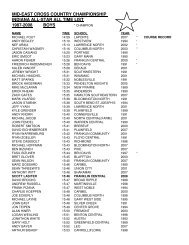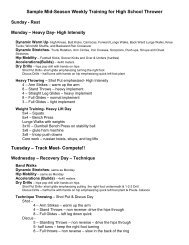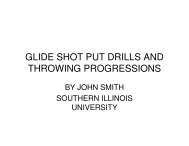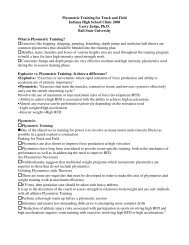Long Jump Training and Drills - iatccc
Long Jump Training and Drills - iatccc
Long Jump Training and Drills - iatccc
Create successful ePaper yourself
Turn your PDF publications into a flip-book with our unique Google optimized e-Paper software.
Testing – Testing is a good way to see if your training is doing what you want it to do. Also giving the<br />
athlete a chance to see improvement. Do this 2-3 times a year. Good way for you to make<br />
adjustments in your training plan. Keep records for each of your athletes.<br />
- Over head shot put<br />
- Underh<strong>and</strong> shot put<br />
- St<strong>and</strong>ing 30m<br />
- Flying 30m (10m run in)<br />
- St<strong>and</strong>ing LJ<br />
- St<strong>and</strong>ing three double leg jumps<br />
<strong>Drills</strong><br />
Be sure that each drill has a purpose. Don’t just do drills to do drills. Athletes must learn to master<br />
the basic drills of the take off!!<br />
When training for the long jump make sure that you as the coach work on training each side of the<br />
body. Being over-developed on one side can lead to problems in the jumps.<br />
Be sure you are working on good posture the entire year!! Good posture leads to good jumps. Bad<br />
posture can lead to bad jumps.<br />
Approach runs are a must. Work up to developing meet approach length.<br />
- Start off the runway first<br />
- Move to runway<br />
- Approach runs with a pop up<br />
- NO FULL JUMPS IN PRACTICE<br />
Master basic skills early <strong>and</strong> continue to work on them throughout the entire year.<br />
- Prep for take-off<br />
- Take-off<br />
- L<strong>and</strong>ing<br />
Short approach jumps vs. Full approach jumps.<br />
- Less stress on the body<br />
- More jumps<br />
- Due to slow nature of the short approach jump this makes the athlete have to do things<br />
correctly.<br />
- Off the board<br />
- Off a box<br />
- Off an incline box<br />
- Off a spring board<br />
Plyometric Exercise are a good tool for any jumper. When incorporating these exercises be sure to<br />
consider the athlete’s ability, age, <strong>and</strong> training age. Contacts per training session will be different for<br />
each athlete. Error on the safe side <strong>and</strong> do less contacts if need be. These exercises can include.<br />
- Short bounds – double or single leg<br />
- In place jumps<br />
- Extended bounds<br />
- Depth <strong>Jump</strong>s
















